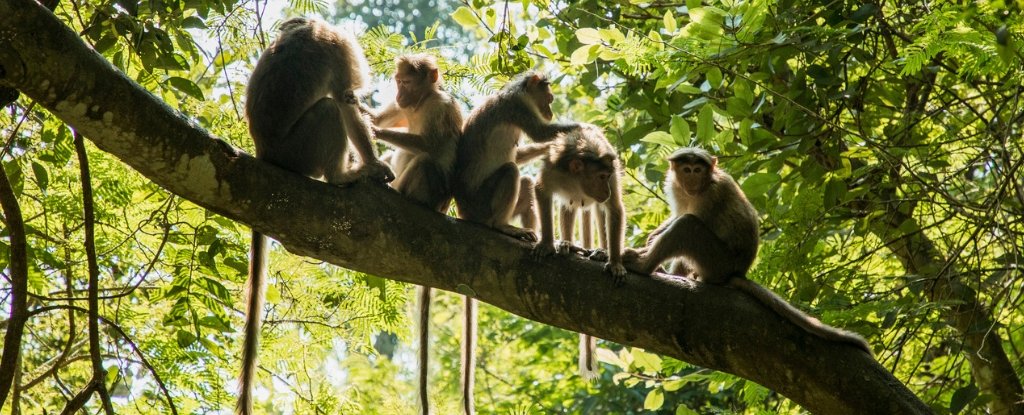
[ad_1]
A critical structure for our brain’s central language pathway, found only in humans and apes, has now also been identified in monkeys, according to a controversial new study, suggesting that the origins of language may have appeared 20 to 25 million years earlier than previously thought.
Compared to other animals, the human brain is uniquely adapted to language. Our ability to produce speech, listen, and communicate with one another is unparalleled, and to understand why, we need to know how we got here.
Unfortunately, brain tissue does not survive on evolutionary time scales, making it difficult to know when the first building blocks of language appeared in our distant past. Today, if we are to locate this lost brain “fossil,” scientists must rely heavily on our living cousins.
Until now, brain imaging studies in chimpanzees have revealed a language circuit similar to that of humans, but the idea that monkeys can also contain something comparable is still hotly debated.
Now some researchers say it is because we have been looking in the wrong place. Although neuroscientists have focused on the prefrontal cortex and temporal lobes, where this pathway exists in humans and apes, the origins of our language may reside in the auditory cortex of rhesus macaques.
“I admit that we were surprised to see a similar pathway hidden in plain sight within the auditory system of non-human primates,” says comparative neuropsychologist Chris Petkov of Newcastle University in the UK.
“It is like finding a new fossil of a long-lost ancestor.”
If the researchers are right, and have really found this missing link, the first neural components for the evolution of language may have appeared much earlier than we thought.
The last common ancestor of macaques and humans lived approximately 25-30 million years ago, and that’s long before the ancestor we shared with chimpanzees, which lived just 5 million years ago.
In humans, speech generally occurs and is perceived along a central language pathway, known as an arcuate fascicle (AF), which spans the prefrontal cortex and the temporal lobe.
Over the years, however, we have come to realize that this circuit is much more complex than we ever thought. It is connected to many other regions of the brain, and some research suggests that the auditory cortex plays a key role.
Comparing the brains of humans, apes, and monkeys along with new imaging data, the new study was able to identify AF in the auditory complex of both halves of the human brain and determine that it was more developed on the left side than on the right.
They then showed that a similar (though less pronounced) pathway existed in the same areas in the brains of macaques and chimpanzees.
Observing how the connection evolved differently in humans, the authors argue that our language system appears to have moved away from relying so heavily on the auditory pathway, involving more temporal and parietal areas of the brain.
“To be honest, we were very surprised that the auditory system has this privileged pathway to regions of vocal production in the frontal cortex,” said Petkov. Newsweek.
“That in itself tells us that there is something special about this pathway. The link to projection of the auditory system to regions of the frontal cortex, which is language-compatible in humans, is fascinating. So we were genuinely surprised to find it there and see that both apes and monkeys have their own version of this path. “
The observations certainly fit the notion that language adaptations may have arisen from primate auditory pathways, which the authors say involve spatial processing as well as sound and voice patterns.
While human language is completely unique, the results suggest that we are not the only ones with sophisticated levels of auditory cognition and vocal communication.
Macaques have been known to communicate about food, identity, or danger with various vocalizations, and perhaps it is this auditory connection that allows them to do that, at least in part.
“This discovery has enormous potential to understand what aspects of human auditory language and cognition can be studied with animal models in ways that are not possible with humans and apes,” says neurologist Timothy Griffiths of Newcastle University.
Such knowledge would also be enormous for the treatment of human patients with neurological problems. The language can be spoken, written, or signed, so even if a stroke patient can no longer communicate through one of these ways, they may have other intact language pathways that are still accessible.
It is an exciting premise, but there is still much to verify. Brain imaging studies can’t tell us everything we need to know, and more research will be needed to explore this auditory pathway in greater detail.
Even Petkov himself admitted to Inverse that this lost brain fossil is “highly controversial.” But given how good it could do, he thinks it’s “important to figure it out.”
The authors suggest that more imaging studies be done in the brains of other monkeys to see how far back in time they can trace this missing link.
The study was published in Nature Neuroscience.